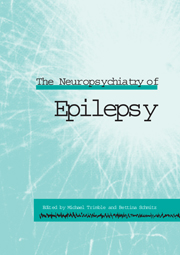Book contents
- Frontmatter
- Contents
- List of contributors
- Part I Background
- Part II Clinical aspects
- Part III Cognitive aspects
- Part IV Nonepileptic attacks
- Part V Treatment complications
- 16 The effects if antiepileptic drugs on behaviour
- 17 Antiepileptic drug treatment and epileptic seizures – effects on cognitive function
- 18 Psychiatric effects of surgery for temporal lobe epilepsy
- 19 Vagus nerve stimulation and mood
- Part VI Treatment
- Index
19 - Vagus nerve stimulation and mood
Published online by Cambridge University Press: 05 October 2010
- Frontmatter
- Contents
- List of contributors
- Part I Background
- Part II Clinical aspects
- Part III Cognitive aspects
- Part IV Nonepileptic attacks
- Part V Treatment complications
- 16 The effects if antiepileptic drugs on behaviour
- 17 Antiepileptic drug treatment and epileptic seizures – effects on cognitive function
- 18 Psychiatric effects of surgery for temporal lobe epilepsy
- 19 Vagus nerve stimulation and mood
- Part VI Treatment
- Index
Summary
Introduction
When asked for their connotations with the vagus nerve, most medically trained people will think of the parasympathetic efferent tasks of cranial nerve X: heart rate modulation, regulation of ingestion/digestion, effects on lung functioning and so on. And these connotations are what gave this nerve its name: vagus, latin the wanderer. However, the vagus nerve is more a sensory than a motor nerve, since it has about 80% afferent but only 20% efferent fibres (Foley and DuBois, 1937). First reports on the cerebral effects of an electrical stimulation of the vagus were published by Bailey and Bremer in 1938. In the following decades, researchers revealed that vagus nerve stimulation (VNS) may influence surface EEG, suppress epileptic electrical activity in the brain, and even terminate seizures in animal models of epilepsy (Zabara, 1985, 1992). The first single-patient trial on VNS for treatment of epilepsy was set up in 1988 in the USA (Penry and Dean, 1990).
The electrical stimulation of the left vagus nerve trunk by a totally implanted stimulation device (NCPTM-system, Cyberonics Inc.) was approved for treatment of drug-resistant epileptic seizures by the FDA in 1997 and by the European Community in 1994 (Schachter and Saper, 1998). The pulse generator is implanted into the chest wall, in a similar fashion to cardiac pacemakers, while the spiral platinum electrodes are attached to the left vagus nerve trunk below the cardiac branch.
- Type
- Chapter
- Information
- The Neuropsychiatry of Epilepsy , pp. 283 - 296Publisher: Cambridge University PressPrint publication year: 2002
- 2
- Cited by



